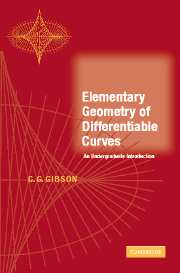Book contents
- Frontmatter
- Contents
- List of Illustrations
- List of Tables
- Preface
- 1 The Euclidean Plane
- 2 Parametrized Curves
- 3 Classes of Special Curves
- 4 Arc Length
- 5 Curvature
- 6 Existence and Uniqueness
- 7 Contact with Lines
- 8 Contact with Circles
- 9 Vertices
- 10 Envelopes
- 11 Orthotomics
- 12 Caustics by Reflexion
- 13 Planar Kinematics
- 14 Centrodes
- 15 Geometry of Trajectories
- Index
7 - Contact with Lines
Published online by Cambridge University Press: 05 June 2012
- Frontmatter
- Contents
- List of Illustrations
- List of Tables
- Preface
- 1 The Euclidean Plane
- 2 Parametrized Curves
- 3 Classes of Special Curves
- 4 Arc Length
- 5 Curvature
- 6 Existence and Uniqueness
- 7 Contact with Lines
- 8 Contact with Circles
- 9 Vertices
- 10 Envelopes
- 11 Orthotomics
- 12 Caustics by Reflexion
- 13 Planar Kinematics
- 14 Centrodes
- 15 Geometry of Trajectories
- Index
Summary
In this chapter we will discuss the way in which curves and lines intersect, via the fundamental idea of ‘contact’. The key concept is the ‘multiplicity’ of a root S of an equation φ(S) = O. Our starting point is to extend the Factor Theorem of elementary algebra from polynomials to smooth functions: that will provide the technical tool necessary to understand the geometry. The next step is to apply this machinery to the pencil of all lines through a given point on a curve to understand how ‘contact’ distinguishes the tangent line at a regular parameter from arbitrary lines. That leads to the more subtle question of the ‘contact’ of the tangent line itself with the curve. The result is a characterization of inflexional parameters in terms of ‘contact’, and the idea of higher inflexions. In the final section we extend this line of thought to special types of irregular parameters (‘cusps’) and establish further connexions with the curvature function.
The Factor Theorem
First we require some vocabulary, extending that familiar from the theory of polynomials in a single variable. Let φ : I → ℝ be a smooth function, with domain an open interval I. A real number t0 which satisfies the equation φ(t) = 0 is said to be a zero of φ.
- Type
- Chapter
- Information
- Elementary Geometry of Differentiable CurvesAn Undergraduate Introduction, pp. 89 - 104Publisher: Cambridge University PressPrint publication year: 2001



